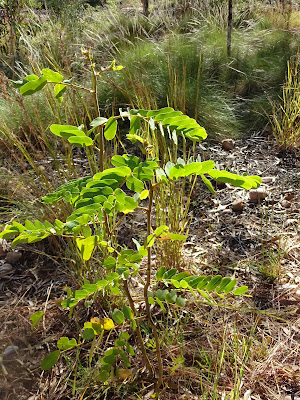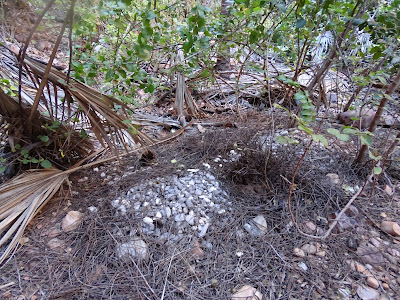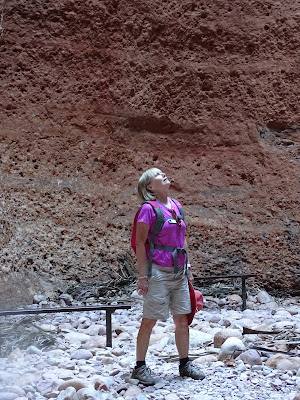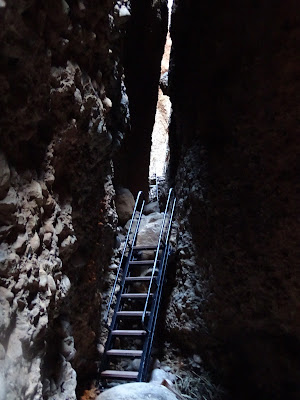We departed the Wilderness Lodge at 7:00 am for the northern Bungle Bungles, where we would hike into Echidna Chasm (2-hours return) and Osmond Lookout.
The 180-metre deep Echidna Chasm cuts knife-like into the rock, formed by millions of years of erosion along a faultline in the sandstone. This northern area of the Bungle Bungle Range features deeply incised gorges which creates a landscape vastly different to the domes in the southern part of the Range. As we set off, my eye was immediately caught by the flora, some of which we had seen previously, but those below were first sightings..
It generally appears in scattered populations in sandy soils, in alluvial areas, and on lower hillslopes.
Livistona Palm (Livistona victoriae)
This species of Livistona Palm is generally confined to sandstone country where is grows in rocky gorges along streams and intermittent watercourses - all habitats that provide permanent seepage water to its roots - amid a gallery forest and eucalypt woodland.
The formation of the chasm is spectacular. Layer upon layer of sand and sediment were deposited here millions of years ago by a large river system from an enormous mountain range, to a depth of several kilometres. Under the pressure of millions of tonnes of weight, the sand and gravel gradually turned into rock. Nowadays, the range is only a few hundred metres high.
No Dave, you can't take it home!
Conglomerate boulder released from the Chasm wall.
The pebbles and rocks are in that shape because they once tumbled along in a fast-flowing river which made them smooth and well-rounded, before the accumulating pressure formed them into Boll Conglomerate rock.
Trekking to the Chasm
The contrast of reds, greens, greys, blues, shadow and light is fascinating
That's where the boulders came from!
On the hike we passed an abandoned Bowerbird nest. The male builds a structure of sticks and twigs, and decorates it with coloured objects such as bones and stones to attract female bowerbirds. After successful courtship dancing by the male, mating takes place in the bower, after which the female builds her nest and rears the young birds alone.
Abandoned Bowerbird bower
This may well be my most favourite photo taken during the Kimberley tour. The rich colour of the cliffs, the delicacy of the palm fronds, the meandering strength of the trunk, the enveloping blueness of the sky!
Livistona Palm silouette
As if the walk to Echidna Chasm wasn't beautiful enough, we fell into awe at the splendor of the narrow Chasm as we passed into the final chamber.
Echidna Chasm, northern Purnululu NP
Entrance to Echidna Chasm
Ray & Steph trekking into Echidna Chasm, northern Bungle Bungles
At places the chasm is only a metre wide
Echidna Chasm - awesome!
Vent in the roof of Echidna Chasm
There are many words that might try to encapsulate the Kimberleys, but tenacity (note the plants in ledges near the ceiling) is one!
Difficult narrow section of Echidna Chasm
Firmly lodged rocks and boulders
Julie; Ray (Guide); Chris; and Leon in Echidna Chasm. It was very hot outside, but very pleasant inside.
The return walk from Echidna Chasm
From left: Helen W; Greg; Colleen; Pier (in the distance); Angela; Steph (in the distance); Julie; Kaylene (in the distance); Noreen; Chris; Sue; Joanne; Brian Mc (obscured); Brian O; Helen F (pink).
Striking colour variations on the return walk from Echidna Chasm
The track to and from Echidna Chasm followed a path alongside the dry bed of Red Rock Creek, and occasionally in the dry bed itself.
Imagine the rough and tumble of water flowing during the Wet
As we neared the end of the return hike, we turned off the main track to visit Osmand Lookout, which presented us with panoramic views of the Osmand Ranges and the northern Bungle Bungles.
A bluff in the nothern Bungle Bungles
A pass between two bluffs in the northern Bungle Bungles
Our group at Osmand Lookout
From the left: Kaylene; Steph; Chris; Leon (hidden); Joanne; Helen F; Helen W; Dave; Angela; Colleen (obscured); Brian O; Pier; Greg (partly obscured); Brian Mc; Noreen; Sue; Karen.
The Osmand Valley
The woodland in the valley is typical of much of the habitat in Purnululu's valley floors. Sparse eucapypts, such as silver box and desert bloodwood cover an understorey of grasses.
Picturesque cairn at Osmand Lookout, with the valley and Range in the background
The Osmand Range
The distinctive curved ridges of the Osmand Range were formed of Proterozoic rocks that vary in age between 1,880 and 1,600 million years ago - two, three, and four times the age of the Bungle Bungle Range. They are not a band of rocks, but an ancient group of sedimentary and volcanic rocks that have been tightly folded and uplifted to form this impressive range.
The valley below Osmand Lookout
The dry bed of Red Rock Creek, and a surrounding population of Silver Box, spinifex, and grasses, viewed from Osmand Lookout. The creek flows into Osmand Creek, and eventually the Ord River.
Upthrust and erosion - with the bus for scale
I try to imagine the forces required to produce this result, but fail miserably! The tenacity and persistence of the climate has worn the mountains down to this beautiful display.
A chasm in the making?
Bungle Bungles to the left, and the Osmand Range to the right
Dave and Steph wending their way from the Osmand Lookout. How small are humans in the greater scheme of things?
The next destination was the Information Centre at Purnululu National Park, for a short break, and then we headed in the bus along the Spring Creek Track to Calico Springs. On the way we saw a jabiru standing on top of a crest of the Bungles Bungles. Very unusual to be so high, because they a normally spend time in the valleys near to water.
Jabiru (Ephippiorhynchus asiaticus Ciconiidae)
The name of the The Black-necked Stork is a little misleading, as the bird’s neck is black only with poor views. At other times, it can be seen to have an iridescent green-and-blue sheen. In northern Australia, the species is traditionally called the Jabiru, but this is not an Indigenous name, as is often supposed, but is a Brazilian name which refers to a totally different species of stork which occurs in South and Central America. Having said that, it is the only stork found in Australia. and is easily identified from all other Australian birds. The legs are long and coral-red in colour. The female is distinguished by its yellow eye - as seen in the photo.

We left the Spring Creek track - quite a rough track that passes through Mabel Downs Station, with some easy creek crossings, but some very bumpy and corrugated sections to contend with (and cattle of course) - and re-joined the Great Northern Highway, heading in a northerly direction towards Warmun (formerly Turkey Creek, after the nearby stream). We had planned to take lunch at the Warmun Arts Centre, but, because of Covid-19, it was closed, so we made a stop at the Warmun Roadhouse, not only for for a picnic lunch, but for icecreams.
Warmun Roadhouse
Rocks around the driveway to the Roadhouse we delightfully decorated with images of local flora and fauna - some of which are included below.
At 2:10 pm, after our lunch break, we continued northwards on the highway to Dillon Springs, where we turned eastwards on to the Victoria Highway towards our destination - the Country Club at Kununurra - a drive of 196 kilometres. The landscape continued in much the same genre of low hills and open savanna.
Open savanna country-side
As we approached the town, and the Victoria Highway crossed the Diversion Dam, we spied a Comb-crested Jacana, which is also known as the Christbird, or Lilytrotter, or Lotus bird. Their long toes help them balance on the lily pads, so that they appear to walk on water. They are quite common throughout coastal areas of northern and eastern Australia.
Comb-crested Jacana (Irediparra gallinacea)


















































Comments
Post a Comment